Marcel Dzama: The End Game features the artist’s film, A Game of Chess, alongside related drawings, paintings, sculptures, and dioramas.
On View: March 9 - August 12, 2012
Dzama’s work draws from a diverse range of references and artistic influences, including Dada and Marcel Duchamp. His film features characters based on the classic game of chess. Dressed in geometrically designed costumes of papier-mâché, plaster, and fiberglass and wearing elaborate masks (including a quadruple-faced mask for the King), the figures dance across a checkered board to challenge their opponents in fatal interchanges.
Chess occupied a central role for the early twentieth-century avant-garde, who drew explicit analogies between the game (with its intricate balance between improvisation and predetermination) and artistic practice. Dzama is influenced by German Bauhaus artist Oskar Schlemmer, whose Triadic Ballet from 1922 included puppet-like, costumed, and masked figures dancing across a checkered surface. French film-maker René Clair and painter Francis Picabia were amongst other artists who integrated ballet and chess in their works from the 1920s, employing the special set of rules and moves of the game as metaphors for larger questions regarding free will, destiny, and technological determinism.
Both the filming and the creation of the costumes for A Game of Chess were carried out in Guadalajara, Mexico, and the influence of local crafts and religious traditions can be felt throughout this body of work. Notions of scapegoatism and resurrection blend with the timeless idea of rivalry represented by the game, and distinctions between reality and fiction ultimately become blurred as both costumed and “real-life” characters in the film are killed. In this way, the storyline recalls the Surrealist predilection for dream logic over conventional narrative form—epitomized by Luis Buñuel’s films from the late 1920s and early 1930s. However, Dzama still retains a strong sense of a plot, with subtle insinuations to contemporary life discernible throughout.
The exhibition also presents two rotating sculptures based on central characters in the film as well as new paintings created especially for this exhibition. Marcel Dzama: The End Game marks the first solo exhibition of Dzama’s work in the Midwest.
Marcel Dzama
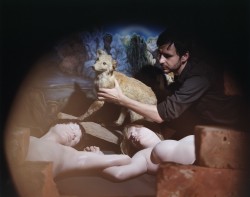
Born in 1974 in Winnipeg, Canada, Marcel Dzama’s work is inhabited by an expansive cast of recurring human, animal, and hybrid characters. Typically manipulating a distinctive palette of muted browns, grays, greens, and reds, the artist has developed an immediately recognizable visual language that penetratingly explores human action and motivation, often by means of the violent, erotic, grotesque, and absurd. His practice unleashes a universe of childhood fantasies and otherworldly fairytales, drawing equally from folk vernacular as from artistic influences that include Dada and Marcel Duchamp. Widely known for his works on paper, Dzama has in recent years expanded his practice to include sculpture, painting, film, large-scale polyptychs, and dioramas. In the latter, he constructs intricate, complex, three-dimensional scenes using his signature drawings, collage elements, cardboard, and occasionally ceramics. He creates a cast of human figures, animals, and imaginary hybrids to life, and has developed an international reputation and following for his art that depicts fanciful, anachronistic worlds.
Dzama's work has been the subject of several solo exhibitions, most recently in 2011 at Gemeentemuseum, The Hague, The Netherlands, and Kunstverein Braunschweig, Germany. In 2010, a major survey was organized by the Musée d’art contemporain de Montréal, Canada. Other important solo exhibitions include the Pinakothek der Moderne, Munich (2008); Ikon Gallery, Birmingham, England; Centre for Contemporary Arts, Glasgow (both 2006); and Le Magasin – Centre National d’Art Contemporain de Grenoble, France (2005). His work has been featured in numerous group exhibitions internationally, including the CCA Wattis Institute for Contemporary Arts, San Francisco (2011 and 2009); Art Gallery of Nova Scotia, Halifax, Canada (2009 and 2004); The Museum of Modern Art, New York (2009, 2008, 2006, and 2005); P.S.1. Contemporary Art Center, Long Island City, New York (2006); Whitney Museum of American Art, New York (2006); among others.
Dzama's work is in the collections of major museums and public institutions, including the Andy Warhol Foundation for the Visual Arts, New York; Corcoran Gallery of Art, Washington, D.C.; Dallas Museum of Art; Musée d’art contemporain de Montréal, Canada; Museum of Contemporary Art, Los Angeles; The Museum of Modern Art, New York; Solomon R. Guggenheim Museum, New York; Tate Gallery, London; and the Vancouver Art Gallery.
Since 1998, his work has been represented by David Zwirner, New York. The artist lives and works in New York.
Works Featured in the Exhibition
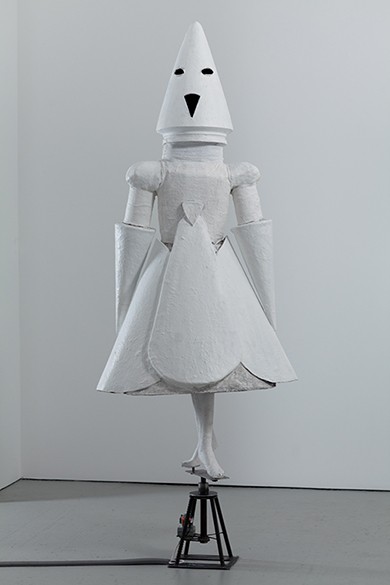
The Queen (La Reina), 2011
Polyester resin, fiberglass, plaster, steel, and motor
Private Collection
The Queen, along with The Rook, also shown in this exhibition, is one of two sculptures depicting characters from the film A Game of Chess. As the film progresses, the white queen slays several of her opponents in her quest for victory. In doing so, the main character, who has been transformed into a black pawn, becomes her foe. Later, the black pawn is promoted to become the black queen, setting the stage for a final deadly showdown.
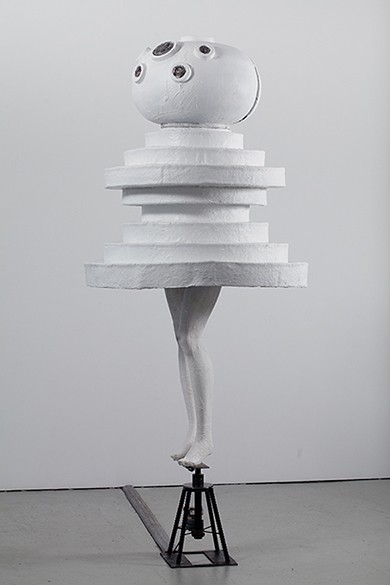
The Rook (La Torre), 2011
Polyester resin, fiberglass, plaster, steel, and motor
Private Collection
One of the white queen’s loyal subjects, the white rook also plays a prominent role in the film, A Game of Chess. Made of circular “slices” of varying sizes stacked atop one another, the costume calls to mind the round shape of a traditional rook while retaining its own unique look.
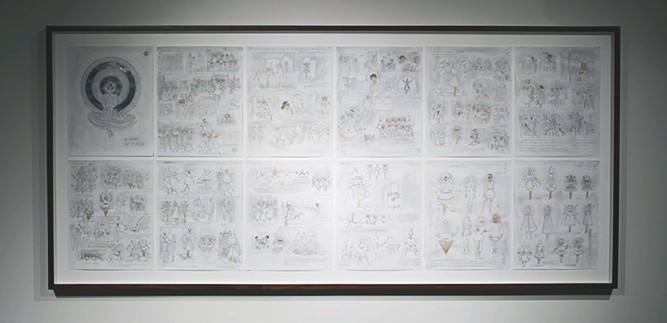
A Game of Chess, 2010
Graphite and watercolor on paper
12 parts
Private Collection
These 12 pages of watercolor and graphite drawings comprise a storyboard composed by Dzama during the planning stages of his film, A Game of Chess. Included are sketches and notes for each scene, as well as sketches of the characters in costume. Though not an exact scene-by-scene recreation of the film, the illustrations and accompanying text provide fascinating insight into the artist’s creative process.
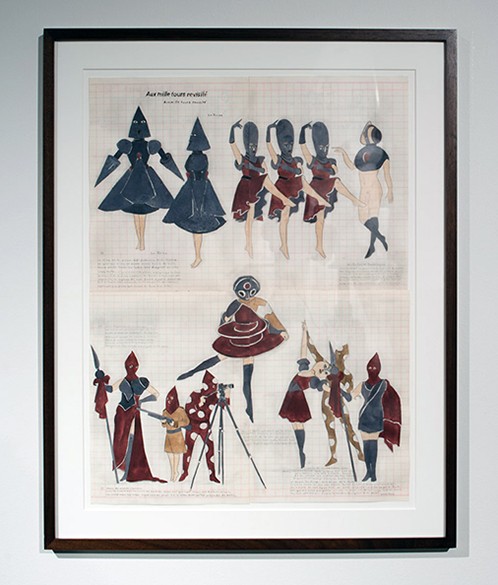
The Queen’s Profile, or Aux mille tours Revisité, 2010
Graphite, watercolor, and ink on paper
4 parts
Courtesy the artist and David Zwirner, New York
Dzama’s muted color scheme is a signature element of his work, both a personal and an aesthetic choice. His preference for a subdued palette is further evident in his choice to film A Game of Chess in black and white. In drawings and paintings like this one, he makes regular use of root beer base as an ink and employs similarly muted tones, including olive green, vermillion, and various shades of gray as complementary colors, drawing inspiration from nature and army textiles.
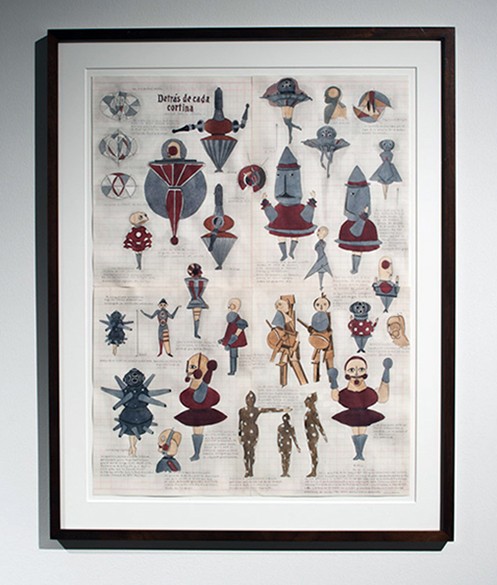
Detrás de cada cortina or Metete un palo en el culo, 2010
Graphite, watercolor, and ink on paper
4 parts
Courtesy the artist and David Zwirner, New York
A continued presence of Spanish names is seen throughout Dzama’s work. Translated, this phrase reads “Behind Every Curtain,” which was the title of an earlier exhibition featuring Dzama’s chess-inspired works at the David Zwirner Gallery in New York. The film A Game of Chess was shot in Guadalajara, Mexico, which the arist calls “a second home,” and is the source of much of his recent artistic inspiration. Many of the visuals—including the papier-mâché costumes and a children’s mariachi band—were based upon local artistic and religious traditions.
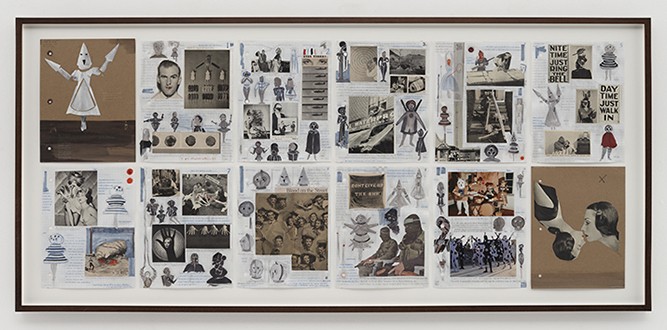
The Strategy of a Pure Symbolic Order, 2011
Collage, pencil, ink, and watercolor on paper
12 parts
Courtesy the artist and David Zwirner, New York
These collages of notes and images trace the conceptualization of many of the characters in A Game of Chess. Clippings are integrated with Dzama’s own sketches, and the two elements seemingly interact with one another. Layered, mixed media works such as these are common in Dzama’s body of work, which includes collages and dioramas. The latter have become a particular Dzama trademark—inspired by displays at natural history museums, he has created large-scale dioramas often inspired by the region of central Mexico where he regularly visits and works.
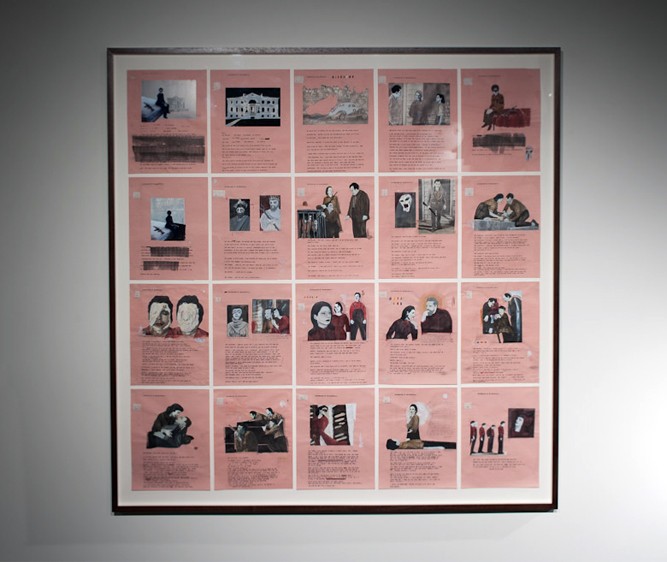
Impressions of Braunschweig, 2011
Ink, gouache, and graphite on paper
20 pages
Courtesy the artist and David Zwirner, New York
These 20 pages comprise the largest unique storyboard that the artist has ever created. Dzama incorporates collage elements with text in a composition that creates a fluid narrative of a draft of a script written with a typewriter, using both English and German dialogue. Portions of the text have been made indecipherable after being crossed out using an antiquated stamp historically used as a security measure, obscuring sensitive or possibly confidential information.
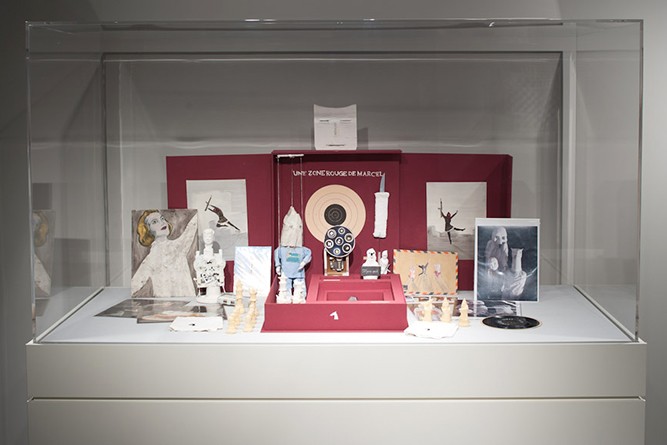
A red box for Marcel, 2009
Fabric, acrylic, wood, plaster, metal, paper, photographs, vinyl record, collage, and string
Edition of 14
Courtesy the artist and David Zwirner, New York
Not only did Marcel Duchamp’s avant-garde style make him arguably one of the most important artists of the twentieth century, he was also an avid chess player. Dzama often cites Duchamp as a major influence in his work. A red box for Marcel is Dzama’s homage to his “namesake’s” Boite-en-valise, in which Duchamp created a “museum in a box” that contained miniature versions of his earlier works. Similarly, A red box for Marcel includes items and relics from Dzama’s body of work—papier-mâché chess pieces, drawings, photographs and even a vinyl record containing an old BBC interview with Duchamp, yet another indication of the earlier Marcel’s impact on Dzama’s career.
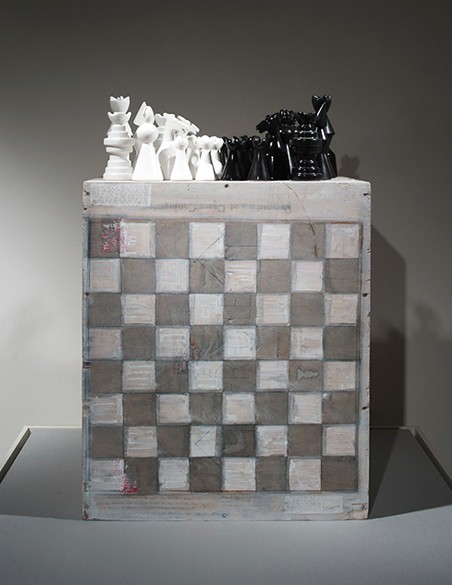
Chess Game, 2011
Board: paint on wood; game pieces: glazed ceramic
32 game pieces
Edition of 25
Courtesy the artist and David Zwirner, New York
Dzama became interested in the making and use of ceramics when he visited a ceramics foundry in Guadalajara, Mexico, where A Game of Chess was filmed. Since that time, he has integrated ceramics into his other works, including the life-sized human sculptures within his many dioramas. The pieces of this chess set, which stand atop a painted wooden board, are another example of his use of the medium. Glazed in black and white, they represent the most literal manifestation of the game in the gallery while retaining a unique Dzama twist.
A Game of Chess
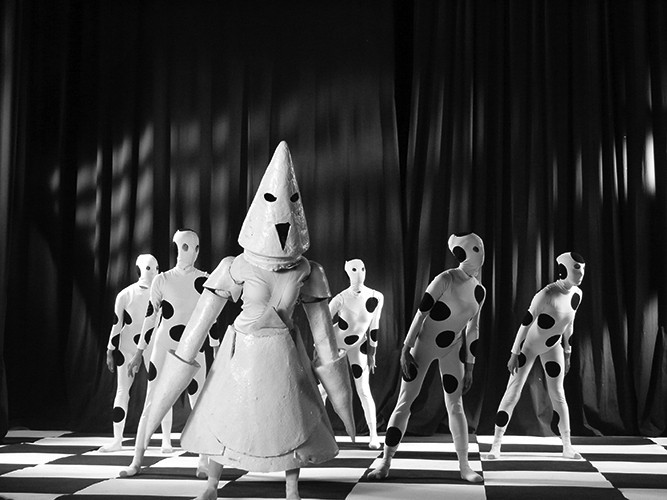
A Game of Chess (film still), 2011
Video projection, 14:02 minutes
Video: Black and white, sound
Private Collection
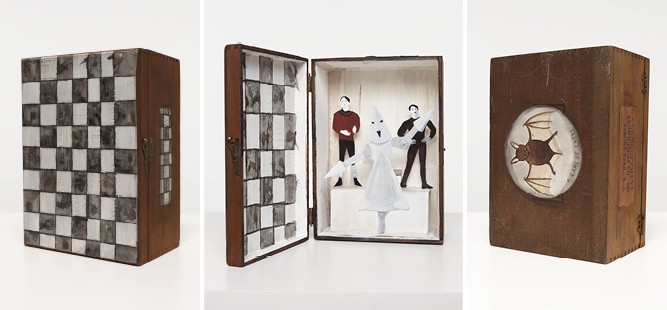
A Game of Chess (Diorama), 2011
Wood, cardboard, paper collage, acrylic, and ink
Edition of 4
Private Collection
This film features characters based on the classic game of chess. Dressed in geometrically designed costumes of papiermâché, plaster, and fiberglass and wearing elaborate masks (including a quadruple-faced mask for the king), the figures dance across a checkered board to challenge their opponents in fatal interchanges. The action occasionally cuts to two men playing chess in a deserted landscape, where two men playing chess appear to be controlling the moves. Distinctions between reality and fiction ultimately become blurred as both costumed and “real-life” characters in the film are “killed.” In this way, the storyline recalls the Surrealist predilection for dream logic over conventional narrative form.
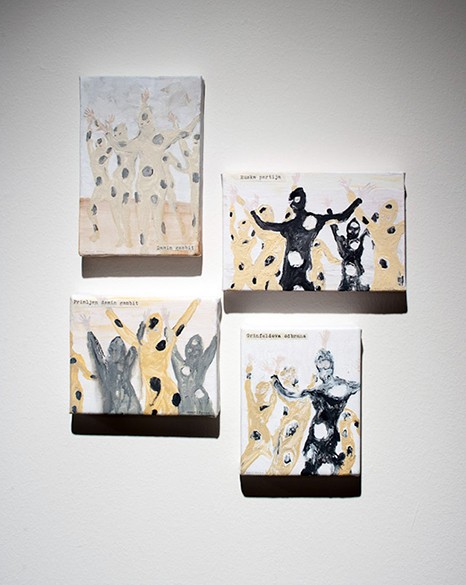
The Pawns Move, 2011-12
Acrylic on canvas
4 paintings
Courtesy the artist and David Zwirner, New York
In addition to Dzama’s usual ink and watercolor drawings, the artist occasionally creates acrylic on canvas paintings. This work was created specifically for Marcel Dzama: The End Game.













